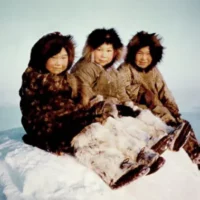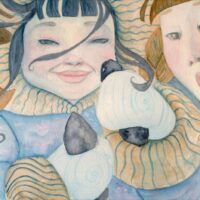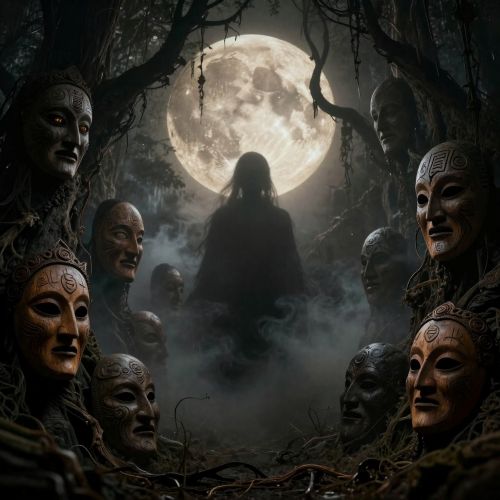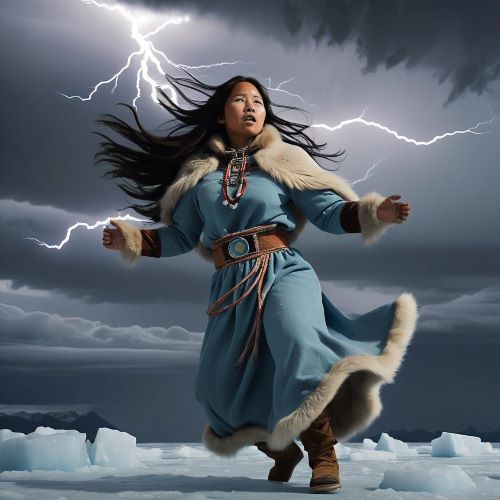Kweetoo : The Lightning Sister
Listen
At a glance
| Description | |
|---|---|
| Origin | Inuit Mythology |
| Classification | Gods |
| Family Members | Kadlu, Ignirtoq (Sisters) |
| Region | Greenland, Canada |
| Associated With | Lightning |
Kweetoo
Introduction
In the heart of the Arctic, where storms sweep across icy landscapes and the sky often blazes with natural phenomena, the Inuit people crafted stories that reflect their deep respect for nature’s raw power. Among these stories is the tale of three divine sisters—Kadlu, Ignirtoq, and Kweetoo—each commanding a different aspect of stormy weather. Kweetoo, the goddess of lightning, is an essential figure in this celestial trio, symbolizing both the beauty and danger of the elements that define the Inuit world.
Physical Traits
Unlike some mythological figures whose physical appearances are described in detail, Kweetoo’s image is left largely to the imagination. This absence in description emphasizes her essence over form—she is lightning. The Inuit saw their gods and spirits not necessarily as humanoid beings, but as representations of the forces they controlled. In that sense, Kweetoo is not defined by shape, age, or attire, but by the blinding streak of light that cuts through stormy Arctic skies.
Some modern interpretations portray her as a luminous figure, glowing with the brilliance of electric energy—perhaps even akin to the aurora borealis. Whether imagined as a young woman cloaked in sparks or as a towering, glowing presence, Kweetoo is an embodiment of energy, illumination, and celestial rhythm.
Family
Kweetoo is one of three sisters who together create and command thunderous weather. This familial connection illustrates a broader theme in Inuit cosmology: the interdependence of nature’s elements. Each sister contributes her own power to a shared dance of storms.
Kadlu, often considered the eldest, is responsible for thunder. Her actions are said to include jumping on hollow ice, singing loudly, or rubbing dried seal skins together—acts that produce the deep, rumbling sounds heard during storms. Ignirtoq, on the other hand, generates rain and sometimes lightning by striking stones together, and in certain tellings, even urinates to make it pour from the skies.
Kweetoo’s own role is unique and vital—she creates lightning by rubbing stones together. This collaborative myth suggests that storms are not chaotic accidents, but well-orchestrated phenomena created by divine play and sisterly teamwork. Their bond reminds listeners that nature is made up of different, balanced forces working together.
Other names
Kweetoo is not widely known outside of Inuit mythology, and there are no recorded alternate names or cultural equivalents for her. This distinctiveness preserves the authenticity and cultural specificity of her story. While her sisters are sometimes collectively referred to as “the Kadlu,” Kweetoo retains her individual identity within the myths.
Her singular role—lightning without thunder or rain—sets her apart even within the trio. This sharp clarity of identity reflects how the Inuit perceive different aspects of nature as having their own spirit and intent, each worthy of recognition.
Powers and Abilities
Kweetoo’s signature ability—to summon lightning—may seem straightforward, but its symbolic meaning runs deep. In the Arctic night, a bolt of lightning is not just a flash; it’s a moment of transformation. It breaks through darkness, startles animals and humans alike, and commands immediate respect. That sudden burst of brilliance mirrors how Inuit mythology approaches nature—not as something to dominate, but as something to revere.
Her method—rubbing stones together—is simple yet deeply evocative. It ties the supernatural directly to the physical world, showing how even sacred forces stem from familiar, tangible actions. Lightning, in this context, is not a foreign miracle, but a direct expression of the land’s living spirit.
Modern Day Influence
While Kweetoo doesn’t frequently appear in popular films or books, her story still holds relevance. As efforts to revive and preserve Indigenous myths gain momentum, figures like Kweetoo are finding their way into new spaces—art installations, educational programs, and digital storytelling platforms.
Contemporary Inuit artists often explore themes of weather, spirit, and survival in their work. Although Kweetoo’s name might not be spoken directly, her influence can be felt in depictions of the northern sky, the interplay of light and shadow, and the celebration of feminine forces of nature. Her myth, like lightning itself, strikes with brief but lasting impact.
Moreover, storytelling remains central to Inuit culture. Through oral traditions passed from one generation to the next, Kweetoo’s tale continues to remind listeners—especially children—of the power of cooperation, the importance of respecting nature, and the magic found in sisterhood.
Related Images
Source
Balladeer’s Blog. (2011, August 21). INUIT MYTH PAGE: THE GODDESS KADLU AND HER SISTERS. https://glitternight.com
Folklore Earth. (2000, January 1). Inuit Mythology – Mythosphere. http://www.folkloreearth.com
Journeying to the Goddess. (2012, November 3). Kweetoo – Journeying to the Goddess. https://journeyingtothegoddess.wordpress.com/2012/11/03/goddess-kweetoo/
Kiddle Encyclopedia. (2024, July 20). Kadlu facts for kids. https://kids.kiddle.co/Kadlu
LinkedIn. (2024, June 12). The influence of mythology in contemporary popular culture. https://www.linkedin.com/pulse/influence-mythology-contemporary-popular-culture
Pinterest. (n.d.). Kweetoo “Goddess of lightning” in Inuit mythology. https://www.pinterest.com/pin/251990541638989911/
Singulart. (n.d.). Angakkuq and three sisters: Kadlu, Kweetoo and Ignirtoq – Oleg. https://www.singulart.com
Strong Nations. (2005, January 1). Unikkaaqtuat: An introduction to Inuit myths and legends. Strong Nations Publishing.
Tocadotexugo. (2024, August 22). Mythology: The timeless influence on modern cultures. https://tocadotexugo.com
Wikipedia. (2002, September 27). Kadlu. https://en.wikipedia.org/wiki/Kadlu
Wolfson, E. (2014, January 1). Inuit mythology. Amazon.
Frequently Asked Questions
What is lorem Ipsum?
I am text block. Click edit button to change this text. Lorem ipsum dolor sit amet, consectetur adipiscing elit. Ut elit tellus, luctus nec ullamcorper mattis, pulvinar dapibus leo.
What is lorem Ipsum?
I am text block. Click edit button to change this text. Lorem ipsum dolor sit amet, consectetur adipiscing elit. Ut elit tellus, luctus nec ullamcorper mattis, pulvinar dapibus leo.
What is lorem Ipsum?
I am text block. Click edit button to change this text. Lorem ipsum dolor sit amet, consectetur adipiscing elit. Ut elit tellus, luctus nec ullamcorper mattis, pulvinar dapibus leo.
What is lorem Ipsum?
I am text block. Click edit button to change this text. Lorem ipsum dolor sit amet, consectetur adipiscing elit. Ut elit tellus, luctus nec ullamcorper mattis, pulvinar dapibus leo.
What is lorem Ipsum?
I am text block. Click edit button to change this text. Lorem ipsum dolor sit amet, consectetur adipiscing elit. Ut elit tellus, luctus nec ullamcorper mattis, pulvinar dapibus leo.











